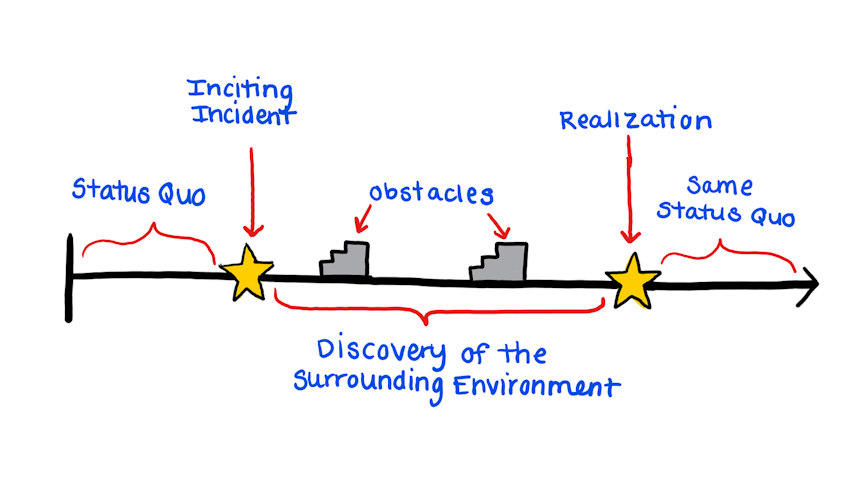With one click
Export a perfectly formatted traditional script.
Having an idea for a main character with a handful of awesome characteristics is unfortunately not enough to transform your script into the next big blockbuster or award-winning TV show. If you really want your screenplay to resonate with readers and eventually viewers, you need to master the art of the character arc.
Export a perfectly formatted traditional script.


Okay, so I need a character arc in my story. What on earth IS a character arc?
A character arc maps out the journey or transformation that your main character experiences over the course of your story. The plot of your entire story is constructed around the character arc you create.
“At its heart every story is about character growth, and the plot and conflict are really just the vessel to both cause that growth and observe it.”
There are 3 types of character arcs commonly used in movie and TV scripts:
In a story with a positive character arc, the main character will exit the story better off than he or she started.
In a story with a negative character arc, the main character will exit the story worse off than he or she started.
In a story with a flat character arc, the main character will exit the story unchanged from how he or she started; however, their perspectives, skills, or environment may have changed.
Start by asking yourself these questions:
Are they comfortable in the status quo? What are their strengths? What are their weaknesses?
An inciting incident is the event that happens in a story which pulls the character out of the status quo and into the plot of your story.
What do they learn from their experiences along the way?
Having discovered more about themselves or their environment (the point of realization), what is the new status quo? Are they better off, worse off, or unchanged from where they started? What are their new strengths and weaknesses?
Once you have answered these questions, you should have a pretty good outline of what your character arc will look like. You can now start filling in more details and shaping your plot around the character arc you want to use!
Note: This section may contain spoilers! Proceed with caution.

A simple and straight-forward example of the positive character arc is the character of the Grinch in How The Grinch Stole Christmas. At the beginning of this short, animated movie, the Grinch is stubborn and hates all things related to Christmas (Status Quo). He devises a plan to dress up as Santa Claus and steal Christmas from the citizens of the nearby town, Whoville (Inciting Incident). However, when he arrives in Whoville and attempts to steal Christmas from all its residents, he discovers, with some help from Cindy Lou Who, that Christmas is not so bad after all (Self-Discovery Through Experience). He returns to Whoville a changed Grinch (Realization) and shares in the holiday festivities with all of the Who’s (NEW Status Quo).

The character of Anakin Skywalker (also known as Darth Vader) from the Star Wars story is an excellent example of a negative character arc. Anakin Skywalker starts out the movie as a good guy and one of the best Jedi (Status Quo). However, when he discovers that his pregnant wife, Padme is in danger of dying in childbirth (Inciting Incident), he begins the search to build his power to save her life. In his search, he abandons the Jedi and joins the “Dark Side” (Self-Discovery Through Experience). The realization of his new status quo occurs in the fiery dual between Anakin (now Darth Vader) and his former Jedi teacher, Obi-Wan Kanobi. After barely surviving the dual and severely burned, Darth Vader begins his new, evil life in his shiny black suit and mask (NEW Status Quo).

For our last example, we will examine the character of Diana Prince (Princess of the Amazons or Wonder Woman, whichever title you prefer) from this year’s version of Wonder Woman. The story begins with Diana living on the isolated island of the Amazons, training to be a warrior. The Amazons know nothing of the world outside of their island other than the Amazonian truth that love can conquer all evil—even that of the wrathful God of War, Ares (Status Quo). A British WW1 soldier’s plane crashes near their island and the Amazons learn of the war outside of their island. Diana, believing Ares must be the cause of the war, decides to return with the soldier, Steve, to end the war and defeat Ares (Inciting Incident). After arriving in London, Steve takes Diana to the front-lines of the war, where she fights alongside the soldiers and experiences the evils of war and Ares first-hand (Discovery of Surrounding Environment). As she begins to uncover the truths of the world, she also begins to doubt her beliefs in love conquering evil. In the end, she conquers Ares by standing strongly by what she knows to be true (Realization) and ends World War 1. Although the world around her has changed, Diana remains largely unchanged as a character (Same Status Quo), which is what classifies her journey as a flat character arc.
Happy Writing!